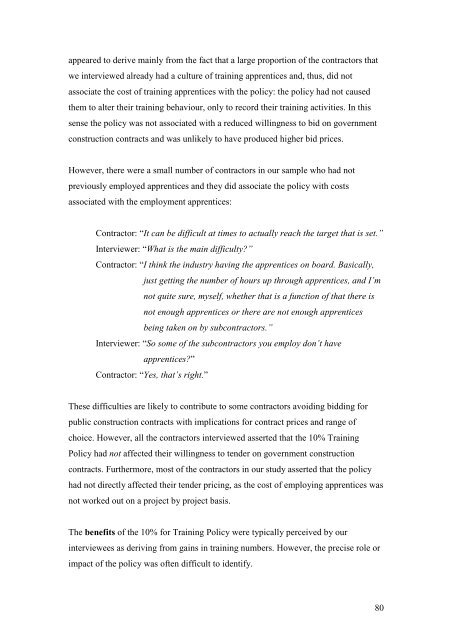Multi Outcome Construction Policy (final report)
Multi Outcome Construction Policy (final report)
Multi Outcome Construction Policy (final report)
You also want an ePaper? Increase the reach of your titles
YUMPU automatically turns print PDFs into web optimized ePapers that Google loves.
appeared to derive mainly from the fact that a large proportion of the contractors thatwe interviewed already had a culture of training apprentices and, thus, did notassociate the cost of training apprentices with the policy: the policy had not causedthem to alter their training behaviour, only to record their training activities. In thissense the policy was not associated with a reduced willingness to bid on governmentconstruction contracts and was unlikely to have produced higher bid prices.However, there were a small number of contractors in our sample who had notpreviously employed apprentices and they did associate the policy with costsassociated with the employment apprentices:Contractor: “It can be difficult at times to actually reach the target that is set.”Interviewer: “What is the main difficulty?”Contractor: “I think the industry having the apprentices on board. Basically,just getting the number of hours up through apprentices, and I’mnot quite sure, myself, whether that is a function of that there isnot enough apprentices or there are not enough apprenticesbeing taken on by subcontractors.”Interviewer: “So some of the subcontractors you employ don’t haveapprentices?”Contractor: “Yes, that’s right.”These difficulties are likely to contribute to some contractors avoiding bidding forpublic construction contracts with implications for contract prices and range ofchoice. However, all the contractors interviewed asserted that the 10% Training<strong>Policy</strong> had not affected their willingness to tender on government constructioncontracts. Furthermore, most of the contractors in our study asserted that the policyhad not directly affected their tender pricing, as the cost of employing apprentices wasnot worked out on a project by project basis.The benefits of the 10% for Training <strong>Policy</strong> were typically perceived by ourinterviewees as deriving from gains in training numbers. However, the precise role orimpact of the policy was often difficult to identify.80
















